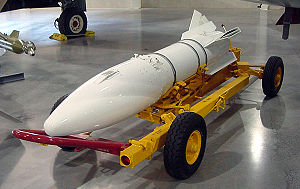AIR-2 Genie
| AIR-2 Genie | |
|---|---|

AIR-2A Genie nuclear air-to-air rocket on a MF-9 Transport Trailer at Hill Aerospace Museum
|
|
| Type | Short-range air-to-air missile |
| Place of origin | United States |
| Service history | |
| In service | 1958–85 |
| Production history | |
| Manufacturer | Douglas Aircraft Company |
| Produced | 1957–62 |
| Specifications | |
| Weight | 822 pounds (372.9 kg) |
| Length | 9 feet 8 inches (2.95 m) |
| Diameter | 17.5 in (444.5 mm) |
| Warhead | 1.5-kT nuclear |
|
|
|
| Engine | Thiokol SR49 |
| Wingspan | 3 ft .4 in (0.9 m) |
| Propellant | Solid fuel |
|
Operational
range |
6 miles (9.7 km) |
| Speed | Mach 3.3 |
The Douglas AIR-2 Genie (previous designation MB-1 and also known as the blivet) was an unguided air-to-air rocket with a 1.5 kt W25 nuclear warhead. It was deployed by the United States Air Force (USAF 1957–1985) and Canada (Royal Canadian Air Force 1965–68, Air Command 1968–84) during the Cold War. Production ended in 1962 after over 3000 were made, with some related training and test derivatives being produced later.
The interception of Soviet strategic bombers was a major military preoccupation of the late 1940s and 1950s. The revelation in 1947 that the Soviet Union had produced a reverse-engineered copy of the Boeing B-29 Superfortress, the Tupolev Tu-4 (NATO reporting name "Bull"), which could reach the continental United States in a one-way attack, followed by the Soviets developing their own atomic bomb in 1949, produced considerable anxiety.
The World War II-age fighter armament of machine guns and cannon were inadequate to stop attacks by massed formations of high-speed bombers. Firing large volleys of unguided rockets into bomber formations was not much better, and true air-to-air missiles were in their infancy. In 1954 Douglas Aircraft began a program to investigate the possibility of a nuclear-armed air-to-air weapon. To ensure simplicity and reliability, the weapon would be unguided, since the large blast radius made precise accuracy unnecessary.
...
Wikipedia
